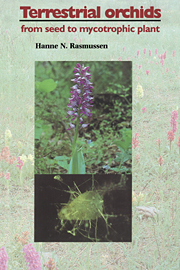Book contents
- Frontmatter
- Contents
- Acknowledgements
- Introduction
- 1 Properties of ‘dust’ seeds
- 2 Seed development
- 3 Seed survival
- 4 Requirements for germination
- 5 Fungi
- 6 Germination processes
- 7 Underground organs
- 8 Orchid mycorrhiza
- 9 Abiotic factors in growth and development
- 10 Life history and phenology
- 11 Propagation
- 12 Effects of orchid mycorrhiza
- 13 Descriptions of genera
- Appendix A Nutrient substrates mentioned in the text
- Appendix B Names and synonyms
- References
- Index
12 - Effects of orchid mycorrhiza
Published online by Cambridge University Press: 13 October 2009
- Frontmatter
- Contents
- Acknowledgements
- Introduction
- 1 Properties of ‘dust’ seeds
- 2 Seed development
- 3 Seed survival
- 4 Requirements for germination
- 5 Fungi
- 6 Germination processes
- 7 Underground organs
- 8 Orchid mycorrhiza
- 9 Abiotic factors in growth and development
- 10 Life history and phenology
- 11 Propagation
- 12 Effects of orchid mycorrhiza
- 13 Descriptions of genera
- Appendix A Nutrient substrates mentioned in the text
- Appendix B Names and synonyms
- References
- Index
Summary
Mycorrhiza is widespread in all groups of higher plants (Stahl, 1900; Allen, 1991). In general mycorrhizal relationships increase the plant's access to soil resources, i.e. water and mineral ions, thereby increasing its drought tolerance and ability to grow in poor and leached soils. Ectotrophic mycorrhiza is thus strongly associated with conditions of mineral nutrient stress (Harley, 1969).
Orchid mycorrhiza differs in important respects from most other types of mycorrhiza (e.g. Smith, 1974; Harley, 1984; Allen, 1991). The green plant functions as the producer of energy in ectomycorrhizal systems, VAM and ericaceous mycorrhiza, but in the mycorrhiza of orchids the fungus is the source of energy and thus provides the plants with a separate nutrition. This may alternate with, supplement or entirely replace the phototrophic nutrition. Although gametophytes of certain pteridophytes and a few specialized groups of higher plants such as Monotropa have established a similar parasitism on fungi, Orchidaceae is the only large plant group that makes consistent use of this kind of nutrition. It is necessary for seedlings of most plants to develop leaves before the nutrient reserves in the seed are exhausted, and for the plants to remain phototrophic throughout their life. In contrast, orchid seedlings have an option of living for extended periods as heterotrophic organisms; this opens habitats and evolutionary pathways for orchids that would not otherwise have been accessible.
Ecological consequences
Importance of light
Since the orchid mycorrhiza represents an alternative source of energy, it is easy to explain how some species of orchids thrive in deep shade where few other plants will grow. This is most evidently true of the species with chlorophyll deficiency.
- Type
- Chapter
- Information
- Terrestrial OrchidsFrom Seed to Mycotrophic Plant, pp. 227 - 237Publisher: Cambridge University PressPrint publication year: 1995



